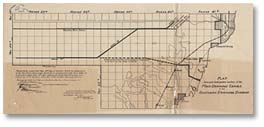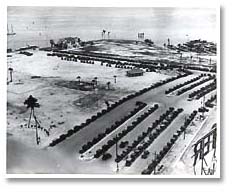|
 Plat
showing the contemplated location of the main drainage canals in the Southern
Drainage District Plat
showing the contemplated location of the main drainage canals in the Southern
Drainage District
Railroad development and land speculation in South Florida
were spurred by the process of draining the Everglades. In 1847, engineer
and surveyor Buckingham Smith recommended the drainage of the Everglades as a
necessary step toward reclaiming the land for development.
The 1850 Swamp Lands Act ceded the land to the state for Florida
for this purpose. The process of drainage began in earnest in the 1880s when a
wealthy Philadelphian, Hamilton Disston, created the Okeechobee Land Company to
develop a system of canals that would facilitate land reclamation. Disston and
others began selling off reclaimed land to railroads, farming interests, and
land developers. By the first years of the twentieth century, inland drainage
operations had set the stage for agricultural development and the rise of the
sugar, citrus, and winter vegetable industries.
 Landfill completed for Bayfront Park
Landfill completed for Bayfront Park
Dredging also created dramatic changes to the landscape. Miami Beach developer
Carl Fisher created the first artificial island in Biscayne Bay, Star Island, in
1917 through dredging operations in the Bay. Soon four additional islands in the
Bay were built through dredging.
The process also allowed for the filling and
extension of the natural shoreline of the Bay.
This option proved fruitful in early efforts to create a "park" along Biscayne
Boulevard, the heart of downtown Miami. The land was owned by the Florida East
Coast Railway (FEC), but the original plat of the City of Miami labeled the site
a park. The Florida State Supreme Court ruled that the land should rightly be
reserved for a park, so the city began purchasing additional lands from the FEC
to create Bayfront Park, dedicated in 1928, whose borders were created, in part,
through infill from the dredging of Biscayne Bay.
|
|

